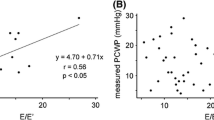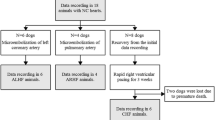Abstract
Although left ventricular (LV) inflow and pulmonary venous (PV) flow variables estimated by transesophageal Doppler echocardiography (TEE) reflect pulmonary capillary wedge pressure (PCWP), they are also affected by changes in cardiac function. The purpose of the present study was to detect the most appropriate variable for the estimation of PCWP by TEE in patients (pts) with ischemic heart disease. Several variables of LV inflow and left upper PV flow were compared with PCWP in 36 pts (six with angina pectoris and 30 with old myocardial infarction). Early diastolic flow (E) and atrial contraction flow (A) were used as LV inflow, while systolic forward flow (X), diastolic forward flow (Y) and atrial contractile reversal flow (z) were used as PV flow. The peak velocity of each flow wave (Ep, Ap, Xp, Yp, and Zp) and the time-velocity integral (Ei, Ai, Xi, Yi, and Zi) were measured. The ratio of Ep to Ap (Ep/Ap), Ei to Ai (Ei/Ai), Xp to Yp (Xp/Yp), Xi to Yi (Xi/Yi), Zp to Ap (Zp/Ap), Zi to Ai (Zi/Ai) and the systolic fraction of PV forward flow were calculated. Among these variables, the Zi/Ai ratio was most strongly correlated with PCWP (R=0.80). The Zi/Ai ratio may not be influeced by atrial function because the augmentation of atrial pump function increases Zi as well as Ai, and this may be one reason why the ratio correlated well with PCWP.Conclusion: The Zi/Ai ratio is a new useful variable for estimating PCWP by TEE.
Similar content being viewed by others
Abbreviations
- Ap:
-
peak velocity of left ventricular inflow during atrial contraction
- Ep:
-
peak velocity of left ventricular inflow during early diastole
- Yp:
-
peak velocity of diastolic pulmonary venous forward flow
- Xp:
-
peak velocity of systolic pulmonary venous forward flow
- Zp:
-
peak velocity of pulmonary venous reversal flow during atrial contraction
- Ai:
-
time-velocity integral of left ventricular inflow during atrial contraction
- Ei:
-
timevelocity integral of left ventricular inflow during early diastole
- Yi:
-
time-velocity integral of diastolic pulmonary venous forward flow
- Zi:
-
time-velocity integral of pulmonary venous reversal flow during atrial contraction
- Xi:
-
time-velocity integral of systolic pulmonary venous forward flow
References
Channer KS, Culling W, Wilde P, Jones JV. Estimation of left ventricular end-diastolic pressure by pulsed Doppler ultrasound. Lancet 1986; 1: 1005–7.
Ettles DF, Davies J, Williams GJ. Can left ventricular enddiastolic pressure be estimated non-invasively? Int J Cardiol 1988; 20: 239–45.
Kuecherer H, Ruffmann K, Kuebler W. Determination of left ventricular filling parameters by pulsed Doppler echocardiography. A noninvasive method to predict high filling pressures in patients with coronary artery disease. Am Heart J 1988; 116: 1017–21.
Iwase M, Yokota M, Maeda M, Kamihara S, Miyahara T, Iwase M, Hayashi H, Saito H. Noninvasive detection of exerciseinduced markedly elevated left ventricular filling pressure by pulsed Doppler echocardiography in patients with coronary artery disease. Am Heart J 1989; 118: 947–54.
Vanoverschelde JJ, Raphael DA, Robert AR, Cosyns JR. Left ventricular filling in dilated cardiomyopathy. Relation to functional class and hemodynamics. J Am Coll Cardiol 1990; 15: 1288–95.
Courtois M, Kovács SJ Jr, Ludbrook PA. Transmitral pressure-flow velocity relation. Importance of regional pressure gradients in the left ventricle during diastole. Circulation 1988; 78: 661–71.
Takagi S, Yokota M, Iwase M, Yoshida J, Hayashi H, Sotobata I, Koide M, Saito H. The important role of left ventricular relaxation and left atrial pressure in the left ventricular filling velocity profile. Am Heart J 1989; 118: 954–62.
Thomas JD, Weyman AE. Echocardiographic Doppler evaluation of left ventricular diastolic function. Circulation 1991; 84: 977–90.
Yoshida K, Yoshikawa J, Hozumi T, Yamaura Y, Akasaka T, Fukaya T, Kato H. Detection of left main coronary artery stenosis by transesophageal color Doppler and two-dimensional echocardiography. Circulation 1990; 81: 1271–6.
Lambertz H, Kreis A, Trumper H, Hanreth T. Simultaneous transesophageal atrial pacing and transesophageal two dimensional echocardiography: A new method of stress echocardiography. J Am Coll Cardiol 1990; 16: 1143–53.
Patel AM, Miller FA, Khandheria BK, Mullany CJ, Seward JB, Oh JK. Role of transesophageal echocardiography in the diagnosis of papillary muscle rupture secondary to myocardial infarction. Am Heart J 1989; 118: 1330–3.
Kuecherer HF, Muhiudeen IA, Kusumoto FM, Lee E, Moulinier LE, Cahalan MK, Schiller NB. Estimation of mean left atrial pressure from transesophageal pulsed Doppler echocardiography of pulmonary venous flow. Circulation 1990; 82: 1127–39.
Nishimura RA, Abel MD, Hatle LK, Tajik AJ. Relation of pulmonary vein to mitral flow velocities by transesophageal Doppler echocardiography. Effect of different loading conditions. Circulation 1990; 81: 1488–97.
Castello RC, Pearson AC, Lenzen P, Labovitz AJ. Evaluation of pulmonary venous flow by transesophageal echocardiography in subjects with a normal heart: Comparison with transthoracic echocardiography. J Am Coll Cardiol 1991; 18: 65–71.
Meijburg HWJ, Visser CA, Westerhof PW, Kasteleyn I, van der Tweel I, Robles de Medina EO. Normal pulmonary venous flow characteristics as assessed by transesophageal pulsed Doppler echocardiography. J Am Soc Echocardiogr 1992; 5: 588–97.
Kuecherer HF, Kusumoto F, Muhiudeen IA, Cahalan MK, Schiller NB. Pulmonary venous flow patterns by transesophageal pulsed Doppler echocardiography: Relation to parameters of left ventricular systolic and diastolic function. Am Heart J 1991; 122: 1683–93.
Nishio H, Matsuzaki M, Tomochika Y, Wasaki Y, Fujino H, Takagi A, Kusukawa R. The assessment of the influence of body positional change on pulmonary venous flow by transesophageal Doppler echocardiography. Jpn J Med Ultrasonics 1992; 19: 104–13.
Tanabe K, Oyake N, Ishibashi Y, Yoshitomi H, Ohota T, Shimada T, Morioka S, Moriyama K. Influence of postural change on pulmonary venous flow in normal subjects. Jpn J Med Ultrasonics 1993; 20: 172–8.
Castello R, Pearson AC, Lenzen P, Labovitz AJ. Effect of mitral regurgitation on pulmonary venous velocities derived from transesophageal echocardiography color-guided pulsed Doppler imaging. J Am Coll Cardiol 1991; 17: 1499–506.
Miyatake K, Izumi S, Okamoto M, Kinoshita N, Asonuma H, Nakagawa H, Yamamoto K, Takamiya M, Sakakibara H, Nimura Y. Semiquantitative grading of severity of mitral regurgitation by real-time two-dimensional Doppler flow imaging technique. J Am Coll Cardiol 1986; 7: 82–8.
Keren G, Sonnenblick EH, Lejemtel TH. Mitral anulus motion. Relation to pulmonary venous and transmitral flows in normal subjects and in patients with dilated cardiomyopathy. Circulation 1988; 78: 621–9.
Hoit BD, Shao Y, Gabel M, Walsh RA. Influence of loading conditions and contractile state on pulmonary venous flow. Validation of Doppler velocimetry. Circulation 1992; 86: 651–9.
Braunwald E, Frahm CJ. Studies on Starling's law of the heart. VI. Observations on the hemodynamic functions of the left atrium in man. Circulation 1961; 26: 633–42.
Matsuda Y, Toma Y, Ogawa H, Matsuzaki M, Katayama K, Fujii T, Yoshino F, Moritani K, Kumada T, Kusukawa R. Importance of left atrial function in patients with myocardial infarction. Circulation 1983; 67: 566–71.
Yamasaki T, Takeuchi M, Fujitani K, Fukuzaki H. Effects of left ventricular dysfunction on left atrial performance in previous myocardial infarction and during pacing-induced myocardial ischemia in angina pectoris. Jpn Circ J 1988; 52: 1240–8.
Payne RM, Stone HL, Engelken EJ. Atrial function during volume loading. J Appl Physiol 1971; 31: 326–31.
Rajagopalan B, Friend JA, Stallard T, Lee GJ. Blood flow in pulmonary veins: II. The influence of events transmitted from the right and left sides of the heart. Cardiovasc Res 1979; 13: 677–83.
Takenaka K, Dabestani A, Gardin JM, Russell D, Clark S, Allfie A, Henry WL. Pulsed Doppler echocardiographic study of left ventricular filling in dilated cardiomyopathy. Am J Cardiol 1986; 58: 143–7.
Kamp O, Huitink H, van Eenige MJ, Visser CA, Roos JP. Value of pulmonary venous flow characteristics in the assessment of severity of native mitral valve regurgitation. An angiographic correlated study. J Am Soc Echocardiogr 1992; 5: 239–46.
Author information
Authors and Affiliations
Rights and permissions
About this article
Cite this article
Habu, H., Sasaki, T., Naito, T. et al. What is the most appropriate variable for estimation of mean pulmonary capillary wedge pressure by transesophageal pulsed Doppler echocardiography?. Int J Cardiac Imag 11, 35–45 (1995). https://doi.org/10.1007/BF01148952
Accepted:
Issue Date:
DOI: https://doi.org/10.1007/BF01148952




